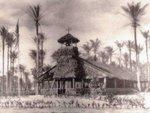WHERE DOES BALSA WOOD COME FROM?
Balsa trees grow naturally in the humid rain forests of Central and South America. Its natural range extends south from Guatemala, through Central America, to the north and west coast of South America as far as Bolivia. However, the small country of Ecuador on the western coast of South America, is the primary source of model aircraft grade balsa in the world. Balsa needs a warm climate with plenty of rainfall and good drainage. For that reason, the best stands of balsa usually appear on the high ground between tropical rivers. Ecuador has the ideal geography and climate for growing balsa trees. The scientific name for balsa wood is ochroma lagopus. The word balsa itself is Spanish meaning raft, in reference to its excellent floatation qualities. In Ecuador it is known as Boya, meaning buoy.
HOW DOES BALSA WOOD GROW?There is no such thing as entire forests of balsa trees. They grow singly or in very small, widely scattered groups in the jungle. For hundreds of years, balsa was actually considered a weed tree. They reproduce by growing hundreds of long seed pods, which eventually open up and, with the help of the wind, scatter thousands of new seeds over a large area of the jungle. Each seed is airborne on its own small wisp of down, similar to the way dandelion seeds spread.
The seeds eventually fall to the ground and are covered by the litter of the jungle. There they lay and accumulate until one day there is an opening in the jungle canopy large enough for the sun's rays to strike the jungle floor and start the seeds growing. Wherever there is an opening, made either by a farmer or by another tree dying, balsa will spring up as thick as grass.
A farmer is often hard put to keep his food plot clear of balsa. As the new balsa trees grow, the strongest will become predominate and the weaker trees will die. By the time they are mature, there may be only one or two balsa trees to an acre of jungle.
HOW LONG DOES IT TAKE A BALSA TREE TO GROW?
Balsa trees grow very rapidly (like all pesky weeds). Six months after germination, the tree is about 1-1/2 inches in diameter and 10 - 12 feet tall. In 6 to 10 years the tree is ready for cutting, having reached a height of 60 to 90 feet tall and a diameter of 12 to 45 inches. If left to continue growing, the new wood being grown on the outside layers becomes very hard and the tree begins to rot in the center. Unharvested, a balsa tree may grow to a diameter of 6 feet or more, but very little usable lumber can be obtained from a tree of this size. The balsa leaf is similar in shape to a grape leaf, only a lot bigger. When the tree is young, these leaves measure a much as four feet across. They become progressively smaller as the tree grows older, until they are about 8 - 10 inches across. Balsa is one of the few trees in the jungle which has a simple leaf shape. This fact alone makes the balsa tree stand out in the jungle.
THE PERFECT NURSE!
Nature evidently designed the balsa tree to be a "nurse tree" which would protect the slower-growing species of trees from the scorching jungle sun during their critical early years. For instance, in an area of the jungle that has been ravaged by a tropical storm or other natural disaster, the balsa trees will quickly sprout and begin to shoot up to impressive heights in a very short time. Their fast growth, and the extra large leaves they have in their early years, provide shade to the young seedlings of the slower-growing forest giants. By the time the seedlings are established enough to take care of themselves, the balsa tree is beginning to die. Undoubtedly, the balsa tree's rapid growth, fast spreading crown of first very large and gradually smaller leaves, and it's relatively short life span were intended to make it the "perfect nurse" in the jungle ecosystem.
HOW ARE BALSA TREES HARVESTED?While nature intended the balsa tree to be a short lived nursemaid, mankind eventually discovered that it was an extremely useful resource. The real start of the balsa business was during World War I, when the allies were in need of a plentiful substitute for cork. The only drawback to using balsa was, and still is, the back breaking work that is necessary to get it out of the jungle. Because of the way the individual balsa trees are scattered throughout the jungles, it has never been possible to use mass production logging procedures and equipment. The best way to log balsa trees is to go back to the methods of Paul Bunyan -- chop them down with an axe, haul them to the nearest river by ox team, tie them together into rafts, and then float the rafts of balsa logs down the river to the saw mill.
The logging team usually consists of two native Ecuadorians, each armed with a broad Spanish axe, a machete, and a long pole sharpened like a chisel on one end for removing the bark from the downed trees. Because of the hilly terrain, an ox team may only be able to drag two logs to the river per day. At the saw mill the raw balsa is first rough cut into large boards, the carefully kiln dried, and finally packed into bales for shipment to the U.S. via ocean freighter. Final cutting and finishing of our model aircraft balsa is done right here at the factory. As a result of the balsa tree's fast growth cycle, both the quality and lightness of the lumber obtained from a balsa tree can vary enormously depending upon the tree's age at the time of cutting.
WHY IS BALSA WOOD SO LIGHT?The secret to balsa wood's lightness can only be seen with a microscope. The cells are big and very thin walled, so that the ratio of solid matter to open space is as small as possible. Most woods have gobs of heavy, plastic-like cement, called lignin, holding the cells together. In balsa, lignin is at a minimum. Only about 40% of the volume of a piece of balsa is solid substance. To give a balsa tree the strength it needs to stand in the jungle, nature pumps each balsa cell full of water until they become rigid - like a car tire full of air. Green balsa wood typically contains five times as much water by weight as it has actual wood substance, compared to most hardwoods which contain very little water in relation to wood substance. Green balsa wood must therefore be carefully kiln dried to remove most of the water before it can be sold. Kiln drying is a tedious two week process that carefully removes the excess water until the moisture content is only 6%. Kiln drying also kills any bacteria, fungi, and insects that may have been in the raw balsa wood.
HOW LIGHT IS KILN DRIED BALSA WOOD?
Finished balsa wood, like you find in model airplane kits, varies widely in weight. Balsa is occasionally found weighing as little as 4 lbs. per cu. ft. On the other hand, you can also find balsa which will weigh 24 lbs or more per cu. ft. However, the general run of commercial balsa for model airplanes will weigh between 6 and 18 pounds per cu. ft. Eight to twelve pound balsa is considered medium or average weight, and is the most plentiful. Six pound or less is considered "contest grade", which is very rare and sometimes even impossible to obtain.
IS BALSA THE LIGHTEST WOOD IN THE WORLD?
No! Most people are surprised to hear that botanically, balsa wood is only about the third or fourth lightest wood in the world. However, all the woods which are lighter than balsa are terribly weak and unsuitable for any practical use. The very lightest varieties don't really resemble wood at all, as we commonly think of it, but are more like a tree-like vegetable that grows in rings, similar in texture to an onion. It is not until balsa is reached that there is any sign of real strength combined with lightness. In fact, balsa wood is often considered the strongest wood for its weight in the world. Pound for pound it is stronger in some respects than pine, hickory, or even oak.
Wednesday, September 9, 2009
All About Balsa Wood Trees
Labels: balsa wood, Ecuador
Subscribe to:
Post Comments (Atom)
The images on this website are protected by copyright.
Please do not use them without permission.
Thought for Today
We need to find God, and he cannot be found in noise and restlessness. God is the friend of silence. See how nature - trees, flowers, grass- grows in silence; see the stars, the moon and the sun, how they move in silence… We need silence to be able to touch souls. ~Mother Teresa






0 Comments:
Post a Comment